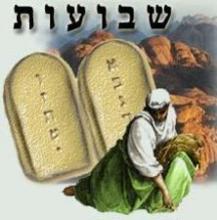This week, Jews around the world will celebrate the holiday of Shavuot. This holy observance commemorates the time when the Israelites received the Torah at Mt. Sinai. It is not as well-known in the non-Jewish world as holidays like Channukah and Passover, but it is still a very important day in Judaism.
Shavuot, a Hebrew word literally meaning "Weeks" is one of the few festivals explicitly described in the Five Books of Moses. It falls on the sixth day of the Hebrew month of Sivan. The term "Weeks" refers to the days in between the first night of Passover and Shavuot which are counted by a special calendar called the Omer. This calendar marks 49 days, with the 50th being Shavuot.
Shavuot, like many ancient holidays, is closely tied to agriculture. It falls on the period of time when the first harvest of the year would have happened for the Israelites. In fact, there are several biblical euphemisms for Shavuot that directly reference the "first fruits". These days, Shavuot has stopped being a harvest festival and is focused almost entirely on the giving of the Torah.
Though it is described in the Torah, there are very few specific observances taken from the Torah for Shavuot. Most of the modern customs are later additions that hope to embrace the spirit of the holiday. Many are small observances stemming from the Eastern European customs of the Ashkenazim, such as eating special dairy products like cheese blintzes and decorating one's house with various forms of greenery.
One of the more intense customs on Shavuot is the practice of Tikkun Leil Shavuot. This is a special nighttime service that consists of several key readings from the Torah. Segments from each of the Five Books are read back-to-back with the complete list of the 613 mitzvot described by the Talmudic scholar Maimonides, as well as several other readings. The practice of the Tikkun Leil Shavuot comes from a 16th century custom of engaging in an all-night session of Torah study. Many modern synagogues have a slightly less extreme version of this, holding a long study session that runs for four to six hours after sundown.
Because Shavuot happens to fall conveniently in the late Spring when school-age kids approach the end of the year's studies, many congregations choose to hold their Confirmation services around the same time as Shavuot. Jewish Confirmation takes place three or four years after a young person's bar or bat mitzvah and it marks the end of the individual's primary Jewish education. This is largely an American Reform tradition, though not exclusively. Unlike the bar and bat mitzvah, Confirmation occurs for an entire class of students, not just individuals.
Shavuot 2009 begins at sundown on Thursday, May 28th and ends the following day at sundown. Whether you decide to stay up into the wee hours in group study or opt for a more leisurely night at home indulging in some tasty cheese blintzes, Judeo Talk wishes a Chag Shavuot Tov and a hearty Shalom to everyone.
